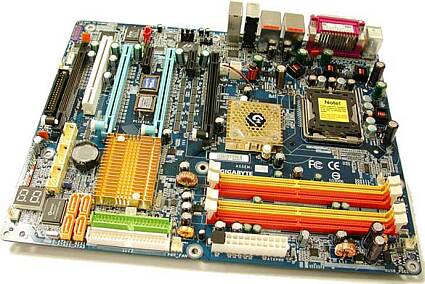One Gigabyte Motherboard, Four Graphics Cards
Conclusion: Waiting For NVIDIA Now
Once more, Gigabyte has managed to surprise us. Although the news about this motherboard has been out since late May, and we couldn't be sure whether quad GPU SLI would work or not, this is by far the most interesting Pentium 4 desktop motherboard we have seen. We hope that it will be available soon, even if it is only for a small number of enthusiasts, or certain user groups such as dealers.
In this board, Gigabyte's pioneering engineering group decided to link two components that were never designed to work together. Well, the 8N SLI Quad Royal works perfectly, running two NVIDIA chipsets at the same time. Thanks to this, the motherboard features 32 PCI Express lanes that can be assigned flexibly to four x16 PCIe slots. The user gets to choose whether to use them for graphics cards, as we did when testing this chameleonic motherboard, or to install other PCIe adapters, whether they are x1 PCIe devices or higher-bandwidth devices such as storage controllers.
A total of ten displays can be attached via the appropriate hardware, which currently means Gigabyte's 3D1 graphics card family - be sure you get revision 2.0. Using regular PCI Express graphics cards, all you need are models based on either ATI or NVIDIA chips; bothwork for multiple display setups.
What is missing, of course, is SLI support. What would NVIDIA lose if it were to agree to Gigabyte's solution and release drivers that support SLI across four GPUs? Well, I guess there is not much to lose by being "first to market" here, especially since only very few people have the tremendous budget needed to go for a super expensive motherboard - we expect a minimum price of $250 - and as many as two dual GPU graphics cards at almost $1,000 each. We certainly do expect the efficiency of a quad GPU setup to be behind what current dual GPU SLI configurations scale. But would anybody willing to go the hardcore way really care?
Get Tom's Hardware's best news and in-depth reviews, straight to your inbox.

Patrick Schmid was the editor-in-chief for Tom's Hardware from 2005 to 2006. He wrote numerous articles on a wide range of hardware topics, including storage, CPUs, and system builds.
-
ShrikeC145 That looks absolutely amazing! Just wondering, what model of graphics cards are they?Reply -
jealousfraud Three ways to Setup Multiple MonitorsReply
1) You can buy a pre-manufactured multi-monitor computer. The best place to purchase a multiple monitor computer is at: Multi-Monitors.com. They carry a multi-monitor computer line called SUPER-PC that can support from 2 to 16 monitors.
Multi-Screen Computer Systems
Multiple Monitor LCD Displays
2) You can get a USB to VGA Adapter, or USB to DVI Adapter that will allow you to add an extra monitor to your computer via any USB2.0 Port. You can also add multiple extra monitors by using multiple adapters. This is a great option for viewing documents, surfing the web, using Microsoft Office and many other business tasks. This is not a good option for intense graphical situations such as HDTV, Blu-ray, Gaming and 3D / CAD Workstation applications. For those types of scenarios, it is highly recommended that you purchase a high-powered multi-monitor workstation or a Matrox Dual or Triple Head2Go.
Multi-Monitor Adapters
3) You can replace or add an extra video card to your existing computer, depending on how many monitors you wish to support. Although this sounds easy enough, this is a rather complex solution for a beginner, especially when trying to find a compatible graphics card. For this reason, I am going to write an entirely seperate post on that topic and will link to it here, very soon.
Multi-Monitor Video Cards
Once you have your multiple monitor system set up and ready to use, you will need to enable all of your monitors in your “Display Properties” Control Panel. Here is a great link to a complete and animated walkthrough of how to enable your multiple monitors in Windows.
How to Setup Multiple Monitors (Instructions)
This is what it will look like when you are done:
Multi-Monitor Video Demo 1Multi-Monitor Video Demo 2
